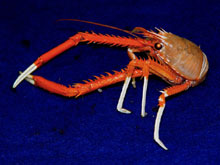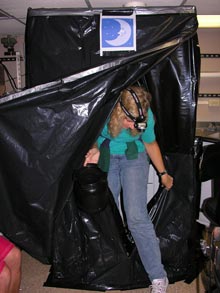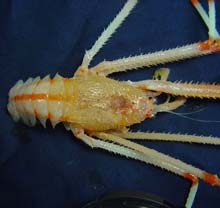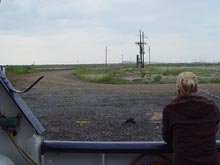
Galatheid crab with a single visual pigment, tentatively identified as Eumunida picta. Click image for larger view and image credit.
Luck of the Draw
August 29, 2005
Tamara Frank, Ph.D.
Biological Oceanographer
Harbor Branch Oceanographic Institute
Latitude: 29° 18.750' N
Longitude: 94° 49.082' W
![]() To
lure hagfish and other non-targeted species away from the circular traps
scientist use a bait bag.. (Quicktime, 792 Kb.)
To
lure hagfish and other non-targeted species away from the circular traps
scientist use a bait bag.. (Quicktime, 792 Kb.)
We've been unable to do any submersible dives for 5 days now, and have spent 4 of those days in port. Initially, mechanical problems with the submersible retrieval system forced us into port, but we've had to remain in port since then due to Hurricane Katrina. However, luck has been on my side. I was fortunate enough to have the only dive at Vioska Knoll, an area of with a great diversity of habitats, ranging from muddy soft bottoms to large areas of limestone knolls (small mounds).
On this dive, we saw an abundance of small crabs, exactly the right size to fit into my traps. We quickly found a location to deploy Edie Widder's Eye-in-the-Sea camera and the redesigned traps together with a decoy bait bag (read more on the August 21 Log). A large hake immediately came up and grabbed the decoy bait bag, completely ignoring the traps. Based on its furious attempts to get at the bait, I suspect that the "decoy" may not have lasted long. As we were leaving the area, I saw two small galatheid crabs marching towards my traps in the murky darkness, apparently ignoring the bait bag. We then started our hunt under dim red/orange illumination, searching for small crabs that could be picked up with the suction sampler and deposited into the Bio-Boxes. We (this being the royal "we", as submersible pilot Tim Askew Jr. was doing all the of the work) managed to get two small crabs (1 to 2 inches wide) and 6 tiny ones(1/2 inch wide) into the Bio-Boxes, and I looked forward to retrieving some additional crabs in my traps - as well as seeing the condition of the bait bag - when they were retrieved in the morning (having not seen a single disgusting hagfish on the entire dive).
Unfortunately, the brake on the winch that controlled the tow line for the submersible failed as the submersible was being launched the next morning, and the dive was cancelled. After working on the winch all day, it was determined that the parts needed to fix it were not onboard, so we made the decision to head into Port Fourchon, about 60 miles south of New Orleans. Port Fourchon is the port that services many of the oil rigs out in the Gulf of Mexico, and, while not exactly a choice spot from an R&R point of view (amenities consist of two bars and one grocery store), a number of repair and service companies with expertise in hydraulic winches are found there. Therefore, this seemed a likely area where parts for a winch made over 20 years ago by a Scottish company that is no longer in business might be available.
As I said earlier, however, luck was on my side, as I have been able to keep the crabs I collected on my dive alive in a cold room (kept at 7o C, the temperature at 1800 ft depth) in light tight boxes. As it takes about 48 hours to complete experiments on one animal, I've been conducting my research the entire time that we've been sitting at the dock. Jon Cohen, a post-doctoral fellow in my lab, has been equally busy, working on sargassum shrimp that he managed to collect with a surface plankton tow while we were underway. The rest of the scientists aren't as lucky. They've all only had one submersible dive each, and while several collected some additional data on several blue water dives, all the data have been worked up by now, so they've had to resort to working on grant proposals, editing manuscripts, or writing manuscripts. We've all been on many research expeditions, and know to bring along extra work, as one can usually count on losing a day or two of work due to weather (even when we're not in the middle of hurricane season). However, this is not work they really want to do - they'd much rather be doing the research they came out here to conduct.

Tammy Frank emerging from her portable darkroom, which contains the crab with which she conducts vision experiments. Ship's crew attached the "moon sign" in acknowledgment of the room's resemblance to an outhouse. Click image for larger view.

Tammy Frank and Jon Cohen continue with their electrophysiological vision experiments, rather lonely-looking in the otherwise empty "dry lab," which on a normal at-sea day would be bustling with science crew. Click image for larger view.
I've finished experiments on three crabs, two of the same species, and a single individual of another
species. The crabs I've been working on are galatheid crabs, also known as squat lobsters.
One species, possibly Eumunida picta, has a very sensitive
eye, perhaps the most sensitive eye I've worked on, and seems to possess a single visual pigment that
is most sensitive to blue light.

Galatheid crab with UV sensitivity. Tentatively identified as Gastroptychus sp. Click image for larger view.
However, the other species, tentatively identified as Gastroptychus sp., appears to have an ultraviolet visual pigment in addition to a blue sensitive one! Ultraviolet vision is not unusual in shallow living crustaceans, as many species of lobsters, crabs, and shrimp have ultraviolet photoreceptors. Ultraviolet light is prevalent in their environment (we can't see it because our lenses block the ultraviolet wavelengths), and UV photoreceptors in these species have been hypothesized to play a role in polarization sensitivity. Some shallow water species, such as stomatopods, have areas on their bodies that reflect UV light, and are used in signaling displays. However, UV light from the surface simply can't penetrate down to 1800 feet, where these crabs are found. The only potential source of light is bioluminescence, and as so little is known about benthic bioluminescence, this remains another oceanic mystery to be solved.



























